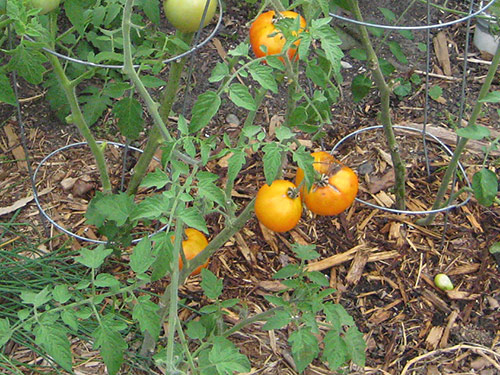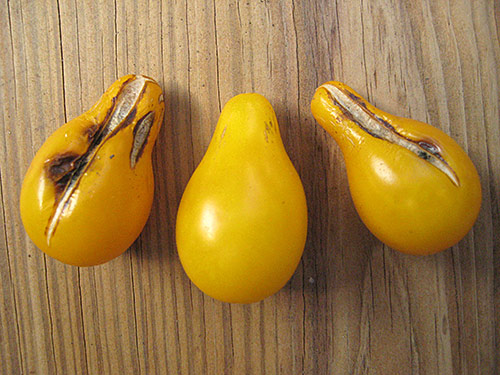The Other Half and I have had two 4’x4′ raised beds for 3 years now. We have attempted and for the most part successfully grown a variety of edibles in those two beds. Each season, and even seasons before we’ve had two dedicated veggie beds, there has been a reoccurring problem with tomatoes.
The Problem? Crack.
No matter which variety of tomato we try to grow, the fruits eventually end up with cracks in the skin. This always seems to happen just when the tomatoes begin to ripen. Here is an example from 2011. The offending tomato is the one in the lower right of the photo.

And here it is again this year in this variety of cherry tomatoes. Some cracks are more like little scars up by the stem area. Other splits in the skin are extreme enough that disease or insects invade the fruit, causing it to begin to rot.

When my neighbor gifted me with flawless, red tomatoes that belonged on the cover of VOGUE, I asked him “why oh why are my tomatoes splitting?” He immediately answered, “too much water.” With his answer in mind I went to research the problem further.
The University of Massachusetts identifies this common tomato growing problem as fruit cracking. According to the article on Tomato Fruit Cracking, irregular water uptake, high temperatures, high humidity, and inadequate calcium levels in the soil can cause tomatoes to crack. With a twinge of guilt, I immediately thought of all the times during the season that I should have watered the veggies but then never got to it. Thank goodness for that nice heavy rain after the dry spell, right?
… *sigh*
Consistent Watering is Key
In a recent article about damage to tomatoes by the Michigan State University Extension Office, the problem is identified as growth cracks. It explains that after a dry period and then heavy watering “the skin expands rapidly at the stem end and cracks happen. Essentially, the tomato got too big too fast and split its pants.”
To prevent cracks in tomatoes the soil should be checked daily for moisture. Water the plant deeply on a regular schedule rather than short, inconsistent watering. If the bed is drying out too fast a layer of mulch can be added around the plant to help retain moisture.
Are You Going to Eat That?
Even though the cracked tomatoes would not fair well in a supermarket, the majority of the time the affected areas can simply be cut out and the fruit can still be eaten. However, if the cracks are severe as illustrated in the two outside tomatoes in the photo above, I’d just throw it in the compost bin. If a tomato is caught beginning to crack on the vine, it is best to pick the fruit and allow it to ripen inside on a windowsill or countertop.